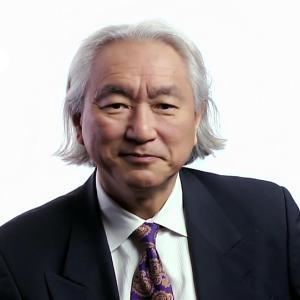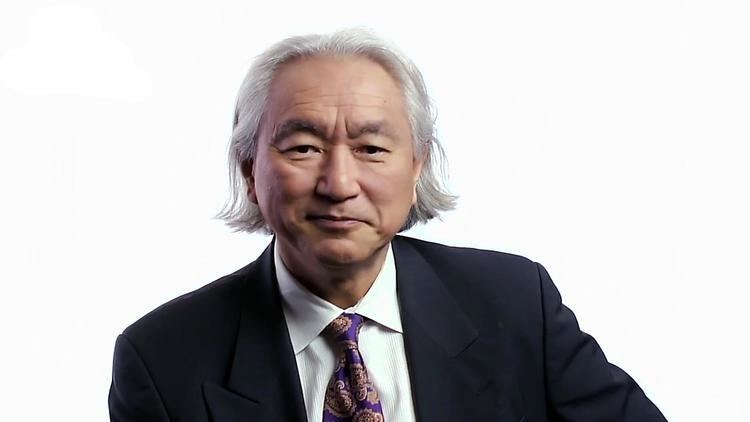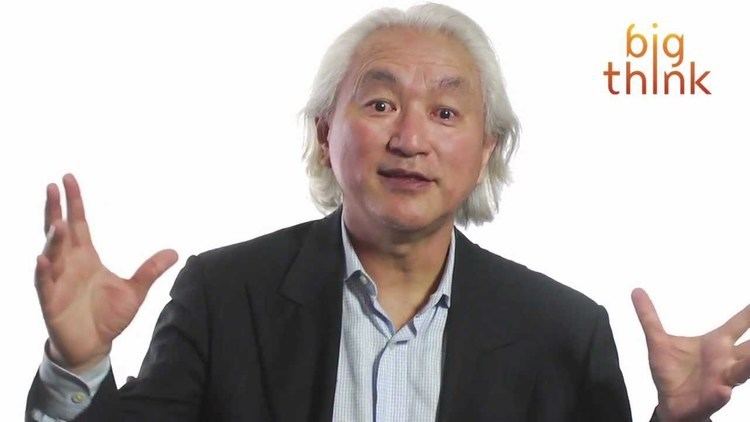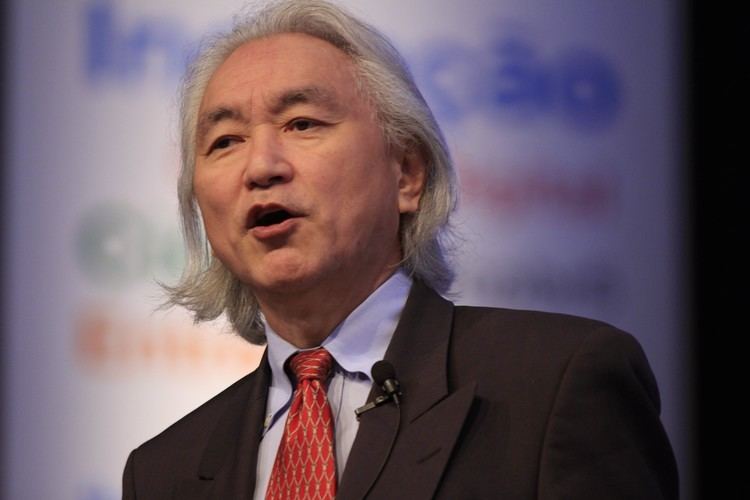Nationality American Role Futurist · mkaku.org Name Michio Kaku | Spouse Shizue Kaku | |
 | ||
Residence New York City, New York, U.S. Institutions City University of New YorkNew York UniversityInstitute for Advanced Study Children Michelle Kaku, Alyson Kaku Books Physics of the Future, The Future of the Mind, Physics of the Impossibl, Hyperspace, Parallel Worlds Similar People Neil deGrasse Tyson, Bill Nye, Stephen Hawking, Carl Sagan, Richard Dawkins Profiles | ||
Michio Kaku's 10 Predictions For The Future
Michio Kaku (; born on January 24, 1947 in San Jose, California) is a Japanese American theoretical physicist, futurist, and popularizer of science. He is professor of theoretical physics at the City College of New York and CUNY Graduate Center. Kaku has written several books about physics and related topics, has made frequent appearances on radio, television, and film, and writes online blogs and articles. He has written three New York Times best sellers: Physics of the Impossible (2008), Physics of the Future (2011), and The Future of the Mind (2014). Kaku has hosted several TV specials for the BBC, the Discovery Channel, the History Channel, and the Science Channel.
Contents
- Michio Kakus 10 Predictions For The Future
- Facts
- Dr michio kaku ufos are real
- Early life and education
- Academic career
- Popular science
- Books
- Radio
- Television and film
- Policy advocacy and activism
- Personal life
- In popular culture
- Works
- References

Facts
Dr michio kaku ufos are real
Early life and education

Kaku was born in San Jose, California, to Japanese American parents. His father, born in California and educated in both Japan and the United States, was fluent in Japanese and English. Both his parents were interned in the Tule Lake War Relocation Center during World War II, where they met and where his older brother was born.

While attending Cubberley High School in Palo Alto, Kaku assembled a particle accelerator in his parents' garage for a science fair project. His admitted goal was to generate "a beam of gamma rays powerful enough to create antimatter." At the National Science Fair in Albuquerque, New Mexico, he attracted the attention of physicist Edward Teller, who took Kaku as a protégé, awarding him the Hertz Engineering Scholarship. Kaku graduated summa cum laude from Harvard University in 1968 and was first in his physics class. He attended the Berkeley Radiation Laboratory at the University of California, Berkeley, and received a Ph.D. in 1972, and that same year held a lectureship at Princeton University.
Kaku was drafted into the United States Army during the Vietnam War. He completed his basic training at Fort Benning, Georgia, and advanced infantry training at Fort Lewis, Washington. However, the Vietnam War ended before he was deployed as an infantryman.
Academic career
As part of the research program in 1975 and 1977 at the department of physics at The City College of The City University of New York, Kaku worked on research on quantum mechanics. He was a Visitor and Member (1973 and 1990) at the Institute for Advanced Study in Princeton and New York University. He currently holds the Henry Semat Chair and Professorship in theoretical physics at the City College of New York.
Kaku had a role in breaking the SSFL (Santa Susana Field Laboratory) story in 1979. The Santa Susana facility run by RocketDyne was responsible for an experimental sodium reactor which had an accident in Simi Valley in the 50s. Kaku was a student involved in breaking the story of the leak of radiation.
Kaku has had more than 70 articles published in physics journals such as Physical Review, covering topics such as superstring theory, supergravity, supersymmetry, and hadronic physics. In 1974, Kaku and Prof. Keiji Kikkawa of Osaka University co-authored the first papers describing string theory in a field form.
Kaku is the author of several textbooks on string theory and quantum field theory.
Popular science
Kaku is most widely known as a popularizer of science and physics outreach specialist. He has written books and appeared on many television programs as well as film. He also hosts a weekly radio program.
Books
Kaku is the author of various popular science books:
Hyperspace was a bestseller and voted one of the best science books of the year by The New York Times and The Washington Post. Parallel Worlds was a finalist for the Samuel Johnson Prize for nonfiction in the UK.
Radio
Kaku is the host of the weekly one-hour radio program Exploration, produced by the Pacifica Foundation's WBAI in New York. Exploration is syndicated to community and independent radio stations and makes previous broadcasts available on the program's website. Kaku defines the show as dealing with the general topics of science, war, peace and the environment.
In April 2006, Kaku began broadcasting Science Fantastic on 90 commercial radio stations in the United States. It is syndicated by Talk Radio Network and now reaches 130 radio stations and America's Talk on XM and remains the only nationally syndicated science radio program. Featured guests include Nobel laureates and top researchers in the fields of string theory, time travel, black holes, gene therapy, aging, space travel, artificial intelligence and SETI. When Kaku is busy filming for television, Science Fantastic goes on hiatus, sometimes for several months. Kaku is also a frequent guest on many programs, where he is outspoken in all areas and issues he considers of importance, such as the program Coast to Coast AM where, on 30 November 2007, he reaffirmed his belief that the existence of extraterrestrial life is a certainty. During the debut of Art Bell's new radio show Dark Matter on September 16, 2013, Bell referred to Kaku as "the next Carl Sagan", referring to Kaku's similar ability to explain complex science so anyone can understand it.
Kaku has appeared on many mainstream talk shows, discussing popular fiction such as Back to the Future, Lost, and the theories behind the time travel these and other fictional entertainment focus on.
Television and film
Kaku has appeared in many forms of media and on many programs and networks, including Good Morning America, The Screen Savers, Larry King Live, 60 Minutes, Imus In The Morning, Nightline, 20/20, Naked Science, CNN, ABC News, CBS News, NBC News, Al Jazeera English, Fox News Channel, The History Channel, Conan, The Science Channel, The Discovery Channel, TLC, Countdown with Keith Olbermann, The Colbert Report, The Art Bell Show and its successor, Coast to Coast AM, BBC World News America, The Covino & Rich Show, Head Rush, Late Show with David Letterman, and Real Time with Bill Maher. He was interviewed for two PBS documentaries, The Path to Nuclear Fission: The Story of Lise Meitner and Otto Hahn and Out from the Shadows: The Story of Irène Joliot-Curie and Frédéric Joliot-Curie, which were produced and directed by his former WBAI radio colleague Rosemarie Reed.
In 1999, Kaku was one of the scientists profiled in the feature-length film Me & Isaac Newton, directed by Michael Apted. It played theatrically in the United States, was later broadcast on national TV, and won several film awards.
In 2005, Kaku appeared in the short documentary film Obsessed & Scientific about the possibility of time travel and the people who dream about it. It screened at the Montreal World Film Festival; a feature film expansion is in development talks. Kaku also appeared in the ABC documentary UFOs: Seeing Is Believing, in which he suggested that while he believes it is extremely unlikely that extraterrestrials have ever actually visited Earth, we must keep our minds open to the possible existence of civilizations a million years ahead of us in technology, where entirely new avenues of physics open up. He also discussed the future of interstellar exploration and alien life in the Discovery Channel special Alien Planet as one of the multiple speakers who co-hosted the show, and Einstein's Theory of Relativity on The History Channel.
In February 2006, Kaku appeared as presenter in the BBC-TV four-part documentary Time which seeks to explore the mysterious nature of time. Part one of the series concerns personal time, and how we perceive and measure the passing of time. The second in the series deals with cheating time, exploring possibilities of extending the lifespan of organisms. The geological time covered in part three explores the ages of the Earth and the Sun. Part four covers the topics of cosmological time, the beginning of time and the events that occurred at the instant of the big bang.
On January 28, 2007, Kaku hosted the Discovery Channel series 2057. This three-hour program discussed how medicine, the city, and energy could change over the next 50 years.
In 2008, Kaku hosted the three-hour BBC-TV documentary Visions of the Future, on the future of computers, medicine, and quantum physics, and he appeared in several episodes of the History Channel's Universe series.
On December 1, 2009, he began hosting a 12-episode weekly TV series for the Science Channel at 10 pm, called Sci Fi Science: Physics of the Impossible, based on his best-selling book. Each 30-minute episode discusses the scientific basis behind imaginative schemes, such as time travel, parallel universes, warp drive, star ships, light sabers, force fields, teleportation, invisibility, death stars, and even superpowers and flying saucers. Each episode includes interviews with the world's top scientists working on prototypes of these technologies, interviews with science fiction fans, clips from science fiction movies, and special effects and computer graphics. Although these inventions are impossible today, the series discusses when these technologies might become feasible in the future.
In 2010, he began to appear in a series on the website Gametrailers.com called Science of Games, discussing the scientific aspects of various popular video games such as Mass Effect 2 and Star Wars: The Force Unleashed.
Kaku is popular in mainstream media because of his knowledge and his accessible approach to presenting complex subjects in science. While his technical writings are confined to theoretical physics, his public speaking and media appearances cover a broad range of topics, from the Kardashev scale to more esoteric subjects such as wormholes and time travel. In January 2007, Kaku visited Oman. While there, he talked at length to select members of that country's decision makers. In an interview with local media, Dr Kaku elaborated on his vision of mankind's future. Kaku considers climate change and terrorism as serious threats in man's evolution from a Type 0 civilization to Type 1 on the Kardashev scale.
He is featured in Symphony of Science's songs, "The Quantum World", "Our Place in the Cosmos", "The Secret of the Stars", and "Monsters of the Cosmos"
On October 11, 2010, Michio Kaku appeared in the BBC program "What Happened Before the Big Bang" (along with Laura Mersini-Houghton, Andrei Linde, Roger Penrose, Lee Smolin, Neil Turok, and other notable cosmologists and physicists), where he propounded his theory of the universe created out of nothing.
Over 22–25 January 2011, Kaku was invited to the fifth annual Global Competitiveness Forum (GCF), held in Riyadh, Saudi Arabia, next to renowned specialists including the British journalist Nick Pope, the Canadian ufologist Stanton Friedman, and the French astrophysicist Jacques Vallée.
Kaku appears on the DVD and Blu-ray extras of the 2012 version of Total Recall, discussing the technological aspects of the future explored in the film.
Policy advocacy and activism
Kaku has publicly stated his concerns over matters including people denying the anthropogenic cause of global warming, nuclear armament, nuclear power and what he believes to be the general misuse of science. He was critical of the Cassini–Huygens space probe because of the 72 pounds (33 kg) of plutonium contained in the craft for use by its radioisotope thermoelectric generator. Conscious of the possibility of casualties if the probe's fuel were dispersed into the environment during a malfunction and crash as the probe was making a 'sling-shot' maneuver around Earth, Kaku publicly criticized NASA's risk assessment.
His remark from an interview in support of SETI, "We could be in the middle of an intergalactic conversation... and we wouldn't even know", is used in the third Symphony of Science installment "Our Place in the Cosmos". Michio Kaku is also a member of the CuriosityStream Advisory Board.
Personal life
Kaku is married to Shizue Kaku and has two daughters, Alyson and Michelle.
In popular culture
In 2016, Kaku appeared in a TV commercial for TurboTax.
